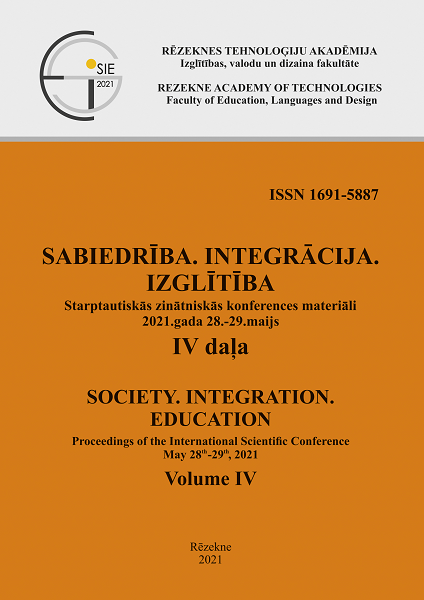CORPORATE IDENTITY DESIGN POLICY IN THE PROCESS OF VISUAL COMMUNICATION
DOI:
https://doi.org/10.17770/sie2021vol4.6483Keywords:
brand, corporate identity design, design development trends, digitalisation. sustainability, visual communicationAbstract
The term corporate identity describes the essence of a company, a set of all the characteristics that make up the company. The company SIA “Nature Line” mentioned in the article, which started its operation as a start-up in the food production industry through the Rēzekne Business Incubator start-up programme, put forward as one of the company’s principal aims to promote the recognition of the company and its products to ensure broad opportunities for product export. One of the objectives for reaching the aim is to create a corporate identity design. A corporate identity design will help the company to start advertising and positioning itself to customers, thus promoting successful company operation. Considering the changing trends, technological opportunities, popularity of the start-up field, and rapid development of visual communication in the modern day, in the article the authors justify the relevance of the chosen topic. The research problem is the lack of understanding on the part of start-ups about the importance of designing a corporate identity for ensuring successful operation of the company as well as insufficient support. The research aim is to explore modern corporate identity development trends in the context of design policy and to analyse expert interviews in order to find out the opinion of experts about the importance of creating a corporate design for ensuring successful operation of a star-up company, about the trends in the graphic design of corporate identity, about the most important elements and their successful positioning. The research results are obtained using the theoretical research methods: the study of scientific and journalistic literature and internet resources, analysis and evaluation, which discover the essence of the problem, as well as expert interviews, which are empirical research methods.
References
Balmer, M.T.J. (2018). Olins, Wallace [Wally]. Oxford Dictionary of National Biography (ODNB). Oxford University Press.
Benton, S., Miller, S., Reid, S. (2018). The Design Economy 2018. Design Council.
Bergstrems, B. (2008). Vizuālā komunikācija. Laurence King Publishing Ltd.
Devereux, L., Melewar, T.C., Dinnie, K., Lange, T. (2019). Corporate identity orientation and disorientation: A complexity theory perspective. Journal of Business Research, 109, 413-424).
Dritz, A. (2014). Closing the sustainability gap: the emerging role or sustainable graphic design. Minneapolis College of Art and Design.
Edmund, R. G., & Balmer, M. T. J. (1998). Managing Corporate Image and Corporate Reputation. Long Range Planning, 31, 695-702.
Gartner Glossary. (2020). Digitalization. Retrieved from https://www.gartner.com/en/information-technology/glossary/digitalization
Gretzel, U., Koo, C., Zhong, L. (2016). Application of smart tourism to cities. National Research Foundation of Korea.
International Council of Design. (2009). AIGA's "Living Principles for Design". Retrieved from https://www.ico-d.org/connect/index/post/1371.php
International Council of Design. (2013). Defining the Profession. Retrieved from https://www.ico-d.org/about/index/sb_expander_articles/9.php
Komprise Data Managment Glossary. (2017). Digital Business. Retrieved from https://www.komprise.com/glossary_terms/digital-business/
Latvijas dizaina gada balva. (2017). Retrieved from http://www.dizainabalva.lv/lv/uzvaretaji/2017/datu-vizualizacijas-riks-infogram
Livingston, D. (2018). Graphic Design, the Communication of Social Issues and the Evolution of the Social Alternatives Design Framework over Forty Years. Social Alternatives, 37(2), 47-52.
Letonika.lv (n.d.). Eksperts. Retrieved from https://www.letonika.lv/groups/default.aspx?g=1&q=eksperts
Mackenzie, D. (1997). Green design. Laurence King publishings.
Malamed, C. (2009). Visual language for designers. Quayside Publishing Group.
Melewar, T.C., Bassett, K., Simoes, C. (2006). The role of communication and visual identity in modern organisation. Corporate Communications: An International Journal, 11(2), 138-147.
Melewar, T., C., & Jenkins, E. (2002). Defining the Corporate Identity Construct. Corporate Reputation Review, 5(1), 76-90.
PontusDati. (2018). Kvalitatīva izpēte. Retrieved from https://pontus.lv/kvalitativa-izpete/
Poon, T. F. S., (2015). Modernisation of Graphic Design: The Possibilities and Challenges of Digitalisation. Journal of Graphic Engineering & Design (JGED), 6(1), 5-9.
Proctor, R. (2009). 1000 new eco designs. London: Laurence King Publishing Ltd.
Proctor, R. (2015). The Sustainable Design Book. London: Laurence King Publishing Ltd.
Simoes, C., & Sebastiani, R. (2017). The Nature of the Relationship Between Corporate Identity and Corporate Sustainability: Evidence from the Retail Idustry. Business Ethics Quarterly 27(3), 1-31.
Social Media Graphics. (2018). Design Tips and Best Practices. Retrieved from https://uxplanet.org/social-media-graphics-design-tips-and-best-practices-820f5ede
Uimonen, P. (2013). Visual identity in Facebook. Visual Studies, 28(2), 122-135.
Wheeler, A. (2013). Designing brand identity. John Wiley & Sons, Inc.
Woxapp. Digitalization Solutions Development. (2018). Retrieved from https://woxapp.com/industries/digitalization-solutions-development/
Wuest, N. (2018). The Future of Corporate Design in the Digital Age. Strichpunkt. Retrieved from https://medium.com/strichpunkt-design/the-future-of-corporate-design-in-the-digital-age-d5ba4272ac8f






